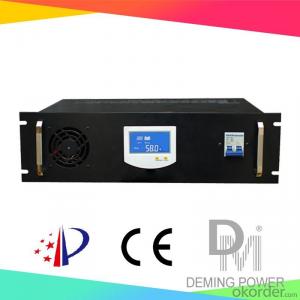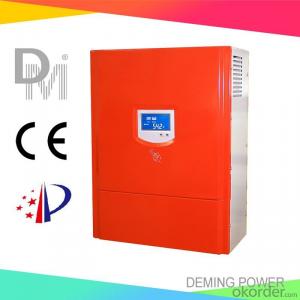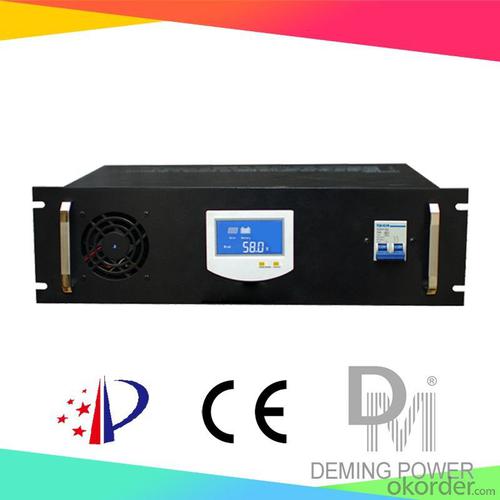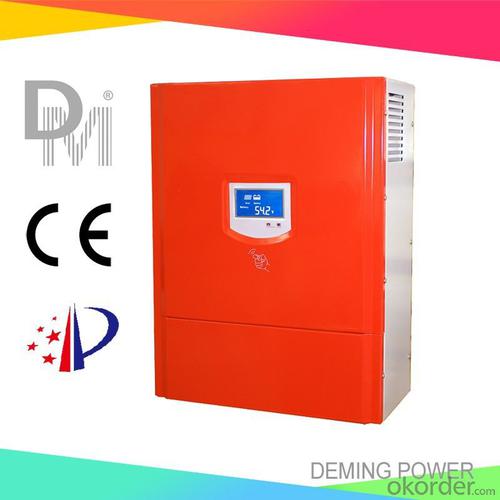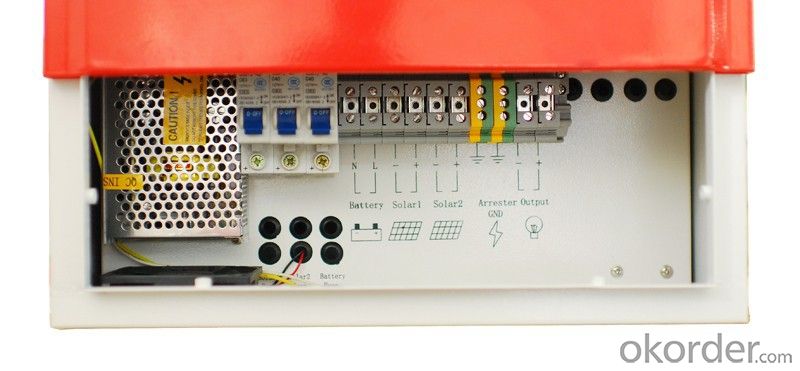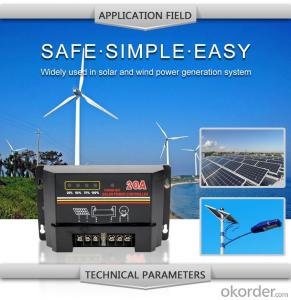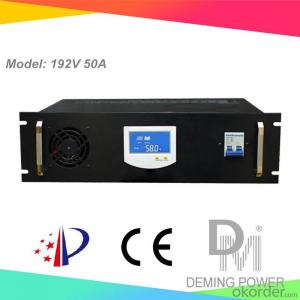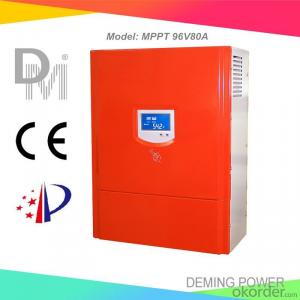High Voltage Solar Controllers - MPPT Solar Charge Controller 96V 60A for Off Grid Solar Power System and RS485 Available
- Loading Port:
- Qingdao
- Payment Terms:
- TT OR LC
- Min Order Qty:
- 1 PCS
- Supply Capability:
- 1000 PCS/month
OKorder Service Pledge
OKorder Financial Service
You Might Also Like
Properties of the solar charge controller
1. Design for off-grid solar power system.
2. Applicable to different kinds of batteries.
3. Adopts MPPT technology (Maximum Power Point Tracking). The advanced tracking algorithm make the solar module operate at ideal voltage which the solar modules can produce the maximum available power.
4. Modular design with simple structure and easy maintenance.
5. Automatic power control function.
6. LCD display: Solar panel current, solar panel voltage, solar panel power, battery group voltage, charge current.
7. Perfect protection function: Solar reverse charge protection, Solar reverse connection protection, Battery reverse connection protection, Battery overcharge protection, Battery over current protection etc ,thus the system has higher reliability.
Technical parameters of the solar charge controller
Model | 96V60A | ||
Battery group rated voltage | 96Vdc | ||
PV Rated current | 60A | ||
PV open circuit voltage | 400V | ||
PV Max. power | 5760Wp | ||
MPPT input DC voltage rang | 80-116Vdc | ||
Input PV module road number | 1 | ||
Function | MPPT charge mode, auto stop charge, auto recharge voltage; Protection: connecting contrary, over current, short circuit, over heat etc. | ||
Display mode | LCD | ||
Display content | solar panel voltage, solar panel current, solar panel power, battery voltage, charge current | ||
Floating Charge Voltage (adjustable) | 110Vdc | ||
Stop charge voltage | 116Vdc±2% | ||
Recharge voltage | 108V±2% | ||
Voltage drop between PV and battery | 1.5V | ||
Max itself power consumption | 100mA-150mA | ||
Work environment temperature | -30-60°C | ||
Relative humidity | 90% No condensation | ||
Applicable altitude | 3000m The rated power should be reduced when it is higher than 2000m | ||
Noise (1m) | 40dB | ||
Degree of protection | IP20(Indoor) | ||
Cooling method | Forced air cooling | ||
*Communication interface (optional) | RS485/USB | ||
*Temperature compensation(optional) | -4mv/°C/2V,-35°C~+80°C,Accuracy:±1°C | ||
Product size (mm) | 520*430*200mm, 480*360*150mm | ||
Weight(kg) | 13Kg, 18kg | ||
*Above parameter only for reference. Could be custom made to user specifications.
- Q: How do you determine the optimal charging voltage for your batteries using a solar controller?
- To determine the optimal charging voltage for batteries using a solar controller, it is crucial to refer to the manufacturer's specifications and recommendations for the specific battery type being used. Solar controllers usually have built-in settings or adjustable parameters that allow users to set the desired charging voltage. Additionally, monitoring the battery voltage and the charge controller's performance can help fine-tune the optimal charging voltage for maximizing the battery's lifespan and performance.
- Q: Can a solar controller be used with solar panels of different technologies?
- Yes, a solar controller can be used with solar panels of different technologies. A solar controller acts as a middleman between the solar panels and the batteries or electrical loads, regulating the flow of energy. It is designed to work with various solar panel technologies, such as monocrystalline, polycrystalline, and thin-film, ensuring compatibility and efficient energy conversion regardless of the panel type.
- Q: What is the purpose of the battery state of charge display feature on a solar controller?
- The battery state of charge display feature on a solar controller serves to offer users real-time information on the remaining charge in the battery. By utilizing this feature, users can keep track of the battery's charge level and make informed decisions about managing their energy consumption. Through the display of the battery state of charge, the solar controller assists users in maximizing their energy usage while preventing the battery from being fully depleted. This capability allows users to monitor the battery's capacity and effectively plan their energy consumption, ensuring a steady power supply at all times. Additionally, the battery state of charge display feature also aids in extending the battery's lifespan. Overcharging or deeply discharging a battery can have a detrimental impact on its overall capacity and longevity. By utilizing this feature, users can easily monitor the battery's state of charge and avoid engaging in these harmful practices, consequently increasing the battery's lifespan. In conclusion, the battery state of charge display feature on a solar controller serves the purpose of providing users with valuable information regarding the battery's charge level. It empowers users to optimize their energy consumption, prevent complete battery depletion, and enhance the battery's lifespan.
- Q: How does a solar controller prevent thermal runaway in batteries?
- A solar controller prevents thermal runaway in batteries by monitoring and regulating the charging process. It ensures that the batteries are charged within their safe operating temperature range, preventing excessive heat buildup. Additionally, the controller may incorporate features like temperature sensors, voltage and current regulation, and overcharge protection to further safeguard against thermal runaway.
- Q: Can a solar controller be used in a solar-powered gate opener system?
- Yes, a solar controller can be used in a solar-powered gate opener system. A solar controller helps regulate and optimize the charging and discharging of the batteries in a solar power system. It ensures that the batteries are charged efficiently and protects them from overcharging or discharging. In a solar-powered gate opener system, the solar controller plays a crucial role in managing the energy flow from the solar panels to the batteries, ensuring reliable and efficient operation of the gate opener.
- Q: How do I connect a solar controller to a battery bank?
- To connect a solar controller to a battery bank, follow these steps: 1. Start by placing the solar controller near the battery bank, preferably within easy reach of both the solar panels and the batteries. 2. Identify the positive and negative terminals on both the solar controller and the battery bank. The positive terminal is typically marked with a "+" sign or a red color, while the negative terminal is marked with a "-" sign or a black color. 3. Connect the positive terminal of the solar controller to the positive terminal of the battery bank using a properly sized cable or wire. Ensure that the connection is secure and tight. 4. Connect the negative terminal of the solar controller to the negative terminal of the battery bank using another appropriately sized cable or wire. Again, make sure the connection is secure. 5. Double-check all connections to ensure there are no loose or exposed wires that could cause a short circuit or other safety hazards. 6. Once all connections are secure, turn on the solar controller and follow the manufacturer's instructions to configure the settings, such as battery type and charging parameters, if necessary. 7. Monitor the solar controller regularly to ensure it is functioning correctly and charging the battery bank efficiently. Adjust the settings as needed to optimize the charging process. Remember to always refer to the manufacturer's instructions for your specific solar controller and battery bank to ensure proper installation and operation. It is also recommended to consult with a professional or an experienced individual if you are unsure about any step of the process.
- Q: Can a solar controller handle power surges from appliances?
- No, a solar controller is not designed to handle power surges from appliances. Its primary function is to regulate and control the flow of power between the solar panels and the batteries, ensuring efficient charging and preventing overcharging. To protect appliances from power surges, separate surge protectors or voltage regulators should be used.
- Q: Can a solar controller handle power surges from the utility grid?
- No, a solar controller is not designed to handle power surges from the utility grid. Its primary function is to regulate and control the flow of power between the solar panels and the battery bank, ensuring optimal charging and preventing overcharging or damage to the battery. To protect against power surges from the utility grid, additional surge protection devices or equipment should be installed in the electrical system.
- Q: What is the role of a solar controller in preventing battery undercharging?
- The role of a solar controller in preventing battery undercharging is to regulate the amount of charge being delivered to the battery from the solar panels. It monitors the battery voltage and ensures that the charging process is stopped or reduced when the battery reaches a certain voltage level. This prevents the battery from being undercharged, which can lead to decreased battery performance and lifespan.
- Q: Can a solar controller be used with both 12V and 24V batteries?
- Yes, a solar controller can be used with both 12V and 24V batteries. Most modern solar controllers are designed to be compatible with various battery voltage systems, allowing users to connect both 12V and 24V batteries to the controller without any issues. However, it is important to ensure that the controller is capable of handling the higher voltage if using a 24V battery system.
Send your message to us
High Voltage Solar Controllers - MPPT Solar Charge Controller 96V 60A for Off Grid Solar Power System and RS485 Available
- Loading Port:
- Qingdao
- Payment Terms:
- TT OR LC
- Min Order Qty:
- 1 PCS
- Supply Capability:
- 1000 PCS/month
OKorder Service Pledge
OKorder Financial Service
Similar products
Hot products
Hot Searches
Related keywords
